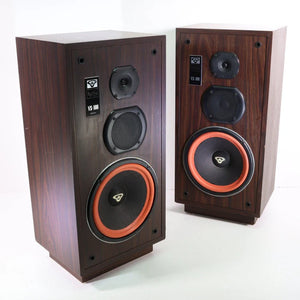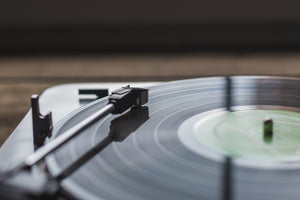We are unable to reply to comments, so please message us directly if you have a specific question regarding products, shipping costs, etc. Our office number is (480) 207-1511. Our email is hello@spencertified.com. You can also message us on Facebook. Commonly asked questions and answers can be found on our FAQs page here.

THE CASSETTE TAPE: ORIGIN STORY
IT’S TIME TO REWIND AND LEARN THE INCREDIBLE HISTORY OF THE COMPACT CASSETTE
The compact cassette, or audio cassette as it’s sometimes called, made an incredible impact on the world of music. The phenomenon of a music medium that was smaller than an 8-track and more portable than a reel-to-reel meant everyone wanted to hit “play” on it. Unfortunately, their lives were relatively short: once CDs were developed, cassette tapes were pushed to the back burner to make way for the shiny new audio medium.
But we’re getting ahead of ourselves. Let’s rewind to the beginning and learn what the buzz around cassette tapes was all about.
WHAT IS A CASSETTE

Let’s start with the basics - A cassette tape holds two small spools of magnetic-coated film inside a plastic exterior. This film is where the audio content is stored, and it passes from one side to the other. The film can support two stereo tracks. Since each plays in opposite directions, the cassette tape can have two “sides” for playback. It can both playback and record audio.
Fun Fact! A 90-minute cassette tape is 443 feet long.
IT STARTS

The origin of the compact cassette is owed to the Philips Company. Developed in 1962 by Dutch engineer Lou Ottens, the small two-spool cassette was introduced to Europe at the Berlin Radio Show in 1963. It was then released in the United States the following year in 1964.
The cassette tape was initially intended for dictation use. It was incredibly compact compared to vinyl and reel-to-reels, yet it could store a significant amount of data. However, it really hit its stride during the 1970s. At this point it became the standard audio format for listening to music. The tapes could be easily stored, transported, and traded. Until then, listening to your favorite music on the go was incredibly difficult. The cassette turned this difficulty into an easy, fun, innovative experience.
IT GROWS

The popularity of the cassette tape was due largely to one of its key features: portability. The compact cassette made it easy and convenient to take music with you wherever you went. The first portable cassette tape player to really gain a stride was the Sony Walkman.
The Walkman was a small, relatively inexpensive handheld device that let people listen to cassettes and AM/FM radio on the go. All you needed was a pair of headphones, and you were all set to hit the road!
Another revolution occurred with the invention of the boombox. It too let people listen to their cassettes and the radio, but this player had built-in oversized speakers (which sounded amazing). The boombox became a staple of Hip-Hop culture, breakdancing battles, and rappers. It also birthed the mixtape. The mixtape was undoubtedly a cultural phenomenon. It allowed people of all ages to create mixes and playlists. They were perfect for road trips and as thoughtful gifts for loved ones.
IT FALLS

Just as in nature, technology is susceptible to survival of the fittest. With the birth of the CD, the Compact Disc, the compact cassette began to fall. The CD came onto the scene with a bang in 1982. After that, they quickly became the most efficient method of storing and playing music. Though some still clung to them, the popularity of cassette tapes began to unspool.
Their popularity declined even further when boomboxes - before then only capable of playing cassette tapes - started incorporating CD players. It was easy too for teenagers to pop down to the nearest Radio Shack to purchase a personal CD player. Portability, the cassette tape’s greatest innovation, was now nothing special.
IT… RETURNS?

Yet what is lost can be found again. And cassette tapes found their foothold again during this last decade. According to Luminate, from 2015 to 2022 cassette tape sales rose 443% in the U.S. Thanks to movies like Guardians of the Galaxy and artists like Beyonce, people fell in love with cassette tapes all over again.
Many hard-core music lovers, audio enthusiasts, and audiophiles never lost their appreciation for the format, but with the help of this recent resurgence of nostalgia, the cassette tape has regained enough popularity that more albums are being released onto it. Cassettes have picked up speed again and, while they may not be spinning out of control, they are on a roll.
SUMMARY
If you grew up during the ’70s and ’80s, chances are good that you had a Walkman, boombox, or full-blown cassette deck. Getting to easily record AM/FM radio for the first time made them a musical marvel.
If you’re like us, who have a fierce love of all vintage equipment, you probably still have a cassette deck. Within the last few years, there’s been a resurgence of the compact cassette in the younger community as well, though not to the degree of vinyl. We’re excited to see where the love of cassettes will go from here.
Thanks for reading! We hope you learned something new about cassette tapes. And if you’re missing listening to your old cassette tapes, feel free to shop our wide selection of refurbished cassette players here. Have a great day!
https://spencertified.com/collections/cassette-player-deck-systems



Comments
Leave a comment